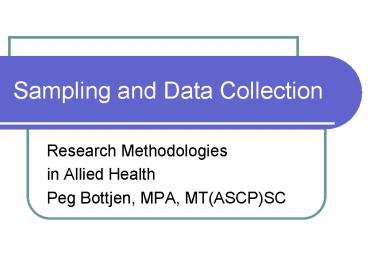Sampling and Data Collection - PowerPoint PPT Presentation
Title:
Sampling and Data Collection
Description:
Sampling and Data Collection Research Methodologies in Allied Health Peg Bottjen, MPA, MT(ASCP)SC – PowerPoint PPT presentation
Number of Views:164
Avg rating:3.0/5.0
Title: Sampling and Data Collection
1
Sampling and Data Collection
- Research Methodologies
- in Allied Health
- Peg Bottjen, MPA, MT(ASCP)SC
2
(No Transcript)
3
Research Process
Planning
Hypothesis or Aims
Research Design
Data collection
Organization and Presentation of Data
Data Analysis
Interpretation and Conclusions
4
Objectives
- Upon completion of this unit the student will be
able to - Outline advantages and disadvantages of three
sampling methods Operationally define the
variables in a study Identify limitations in
research studies Choose the method of data
collection that best facilitates proving or
disproving a hypotheses or best answers a
research question Explain how a test can be
valid yet not reliable.
5
Boundaries of the Study
- Define the terms
- Dictionary definitions
- ex. BMI wt (kg) / ht2 (m)
- Reference to a definition
- ex. NHANES II study
- Operational definitions
- ex. obesity gt95th percentile
6
Operational Definition
- The operational definition of a variable is a
statement of how the researcher in a particular
study chooses to measure the variable in question.
7
More Boundaries of the Study
- Assumptions
- Scope
- Limitations
- Subjects
8
Sampling
Target Population
Representative Sample
X
X
X
X
X
9
Representative Sampling Methods
- Randomized roll of dice
- Area - location
- Systematic choose from list (every 5th)
- Volunteer ask for participants
- Convenience what is available
10
Subjects
- Inclusion
- Exclusion
11
Sample Size
- It depends!
- Procedures used to collect data
- Statistical level of significance
- Statistical power
- Effect size
12
External Validity
- The extent to which the results of an
investigation can be generalized to other samples
or situations.
Polgar Thomas-4th Ed. 2001
13
Internal Validity
- The intervention was responsible for the
differences or lack of differences observed.
14
Data Collection Methods
- Questionnaire
- Interview
- Observation
- Measurement / instrumentation
15
Questionnaire
- Define information needed
- Draft questions
- Do pilot
- Redraft
- Administer questionnaire
16
Questionnaire
- Open vs Closed questions
- Scaled questions or statements
- Likert scale
- Strongly disagree, disagree, no opinion, agree,
strongly agree - Semantic differential
- Draw an x at point that best describes your
feeling - Powerless
Powerful
X
17
Interview
- Structured
- Unstructured
18
Observation
- Who is observer
- Setting of observation
- Use of instrumentation
19
Observation
- Complete participant
- Participant as observer
- Observer as participant
- Complete observer
20
Measurement / Instrumentation
- Subjective measurements
- Ratings or judgments by humans of quantities or
qualities - Objective measurements
- Measurement of physical quantities or qualities
by equipment
21
Measurement / Instrumentation
- Objective measurement
- Data collected by instrumentation
- Eg. Blood glucose, MR/CT scans, radiographic
image, nuclear medicine scan, activated clotting
time (ACT), nutrition screening instrument,
stained slide read by expert - Data collected by standardized tests
- Eg. SAT, ACT, GRE, CAT, Myers-Briggs, IQ test,
patient quality of life (SF-36)
22
Desirable Properties of Measurement Tools
- Reliability
- Validity
- Applicability
- Practicality
23
Reliability - Precision
- The test or assessment measures the same thing
every time and results in the same answer every
time. - Test-retest correlates 1st to 2nd
- Inter-observer between different observers
- Internal consistency between items
measured
24
Validity - Accuracy
- The test or assessment measures what it claims to
measure. - Sensitivity - true positive
- Specificity - true negative
Test Result Disease Present Disease Absent
True False
- False - True -
25
Validity of Mammography
Mammography Result Known Breast Cancer
169 ( true )
- 49 (false -)
26
Validity
- Predictive value
- Ability of a measurement to predict the value of
it or another test in the future (prognosis) - What is predictive value of an ACT score to your
grade point average in college?
27
(No Transcript)
28
Summary
- Boundaries of the study
- Sampling
- Data Collection Methods
- Reliability/ Validity
29
Critical Evaluation of Research
- Who comprised the sample?
- What was the inclusion criteria?
- What was the exclusion criteria?
- Was the sample biased?
- How is the independent variable defined?
- How is the dependent variable defined?
- How were validity issues addressed?
- How were reliability issues addressed?
30
Group Work
- Questions 9 16 in the Research Proposal
Notebook are designed to lead you through the
process of the literature review, defining the
research question, and selecting a research
design. Answer each question in your group.
Submit your results as described under
Assignments.































